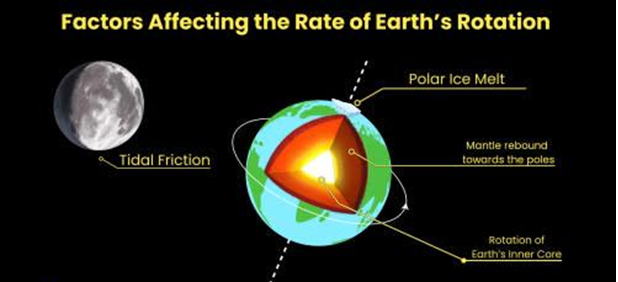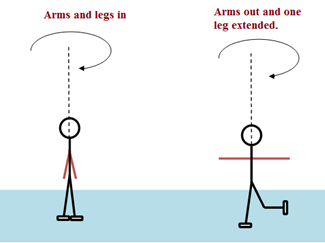MELTING POLAR ICE DUE TO CLIMATE CHANGE IS MAKING EARTH’S DAYS LONGER
Relevance:
- GS 1 – Salient features of world’s physical geography;
- GS 3 – Conservation, environmental pollution and degradation, environmental impact assessment.
Why in the news?
- Over the last two decades, scientists have observed that the Earth’s rotation rate has slowed by approximately 1.3 milliseconds per century.
- Due to the ongoing melting of polar ice caps, climate change is now contributing to a slower rotation of the Earth.
More about the news
- This deceleration leads to slight changes in the actual duration of a day, though these changes have minimal impact on daily human activities.
- The slowing of the Earth’s rotation could affect technologies that depend on precise timekeeping, including computer networks and space travel systems.
- As we expand our connections on Earth and in space, the reliability of these technologies could be compromised by the Earth’s changing rotational dynamics.
Conservation of Angular Momentum and Earth’s Rotation
Angular Momentum:
- The concept of conservation of angular momentum explains the changes in Earth’s rotation due to polar ice melt.
- When an ice-skater pulls their arms in tightly while rotating, their moment of inertia decreases, causing them to spin faster.
- Conversely, when they stretch their arms out wide, their moment of inertia increases, leading to a slower spin.
- This occurs because angular momentum, which is the product of moment of inertia and angular velocity, remains conserved regardless of how the skater is spinning.
- Similarly Earth’s rotation is affected by mass distribution.
Pole-to-Equator Mass Flux:
- As polar ice sheets and glaciers melt, the mass shifts from the poles to the equatorial regions, known as pole-to-equator mass flux.
- Increased Oblateness and Slower Rotation: The melting ice causes Earth’s equatorial region to bulge slightly, increasing its moment of inertia and leading to a slower rotation.
- Lengthening of Days: The redistribution of mass towards the equator results in a slower rotation, lengthening the time it takes for Earth to complete one rotation, thus increasing the length of our days.
- Projected Acceleration of Slowdown: Under high emission scenarios, this deceleration rate could double to 2.6 milliseconds per century, making climate change the primary factor in slowing Earth’s rotation.
- Mostafa Kiani Shahvandi, a geophysicist and author of a paper detailing the recent findings in “https://www.pnas.org/doi/10.1073/pnas.2406930121“
A Significant Impact on Earth’s Rotation
- Study Overview: Scientists used a combination of climate models and real-world data to analyze a 200-year period from 1900 to 2100, focusing on the effects of climate change on Earth’s rotation.
- Recent Findings: Over the last two decades, climate-induced changes in sea levels around the equator have slowed Earth’s rotation by approximately 3 milliseconds per century.
- Future Projections: If high emission scenarios continue, this deceleration could increase to 6 milliseconds per century, making climate change the dominant factor in slowing Earth’s rotation.
- Significance of Climate Impact: Duncan Agnews, an emeritus professor of geophysics at the Scripps Institute of Oceanography, emphasized that this change, though small, highlights the significant impact of climate change on Earth’s physical characteristics.
- Timekeeping Implications: The slight deceleration of Earth’s rotation, measured in milliseconds, can affect precise timekeeping with atomic clocks. While these clocks have been used since the 1950s, they must be synchronized with Earth’s rotational period, which varies slightly and sometimes requires adjustments, similar to how leap days account for the Earth’s slightly longer revolution around the sun.
Importance of a Second in Precise Timekeeping
- Lunar Tidal Friction: The process of lunar tidal friction, where the Moon’s gravitational pull on Earth’s oceans slows the planet’s rotation by approximately 2 milliseconds per century, is a key factor in the gradual lengthening of days.
- Cumulative Effect: Currently, Earth takes about 2 milliseconds longer to complete a day than predicted by atomic clocks. In 100 years, this difference could increase to 4 milliseconds. To keep time accurate, leap seconds are occasionally added to account for this cumulative effect.
- Impact on Critical Systems: While these changes are imperceptible to humans, they can disrupt systems that rely on precise timekeeping, such as GPS, stock trading, and space travel.
- Significance of a Second: Agnews highlights that in the world of precise timekeeping, even a second is significant.
- Opposing Forces: Other processes, like the Earth’s core’s slowed rotation and post-ice age crustal rebound at the poles, have been counteracting the slowing effect, slightly speeding up Earth’s rotation. This has led to discussions among scientists about the potential need for a negative leap second to adjust for this acceleration.
The Shifting Axis and Climate Change
- Impact on Earth’s Rotation: Agnews published a paper in Nature in March, demonstrating that climate change and the melting of ice are not only slowing Earth’s rotation but also potentially delaying the need for a negative leap second.
- Global Influence of Climate Change: Both studies underscore how climate change is affecting the entire planet, influencing even fundamental aspects like Earth’s rotation around its axis.
- Polar Ice and Axis Shift: Shahvandi and his team published another paper in Nature Geophysics, showing that melting polar ice and glaciers are contributing to the Earth’s polar motion. Using observed data and physics-informed neural networks, they found that the Earth’s axis of rotation is slowly shifting where it intersects the crust.
- Rising Sea Levels and Greater Risks: While the wobble of Earth’s axis or the gradual lengthening of days may seem minor, the melting ice has far more severe consequences, such as rising sea levels that threaten low-lying coastal areas.
- Urgent Need for Action: These findings highlight the urgent need to curb emissions and address climate change before its effects become even more severe and uncontrollable.
Way Forward: Addressing the Impact of Climate Change on Earth’s Rotation
- Increase Awareness and Education: Develop educational programs to inform the public about the effects of climate change on Earth’s physical systems, including rotation.
- Enhance Climate Research: Fund and promote research focused on the relationship between climate change and Earth’s rotational dynamics.
- Develop Adaptive Technologies: Invest in research to create more resilient timekeeping systems that can adapt to changes in Earth’s rotation. Improve the accuracy of GPS and other navigation systems to account for the gradual changes in Earth’s rotation.
- Implement Climate Mitigation Strategies: Advocate for policies that promote renewable energy sources and reduce reliance on fossil fuels. Promote sustainable agriculture, transportation, and urban planning to minimize environmental impact.
- Execute Climate Agreements: Engage in global climate agreements (e.g., Paris Agreement) to set and achieve emission reduction targets.
- Establish Monitoring Programs: Create programs to continuously monitor changes in sea levels, polar ice melt, and their impact on Earth’s rotation.
- Develop Contingency Plans: Prepare for potential disruptions in technologies reliant on precise timekeeping, including contingency plans for industries like finance and space exploration.
- Encourage Investment in Green Technologies: Lobby for government and private sector investment in technologies that can mitigate climate change effects.
Alternative articles
- https://universalinstitutions.com/chapter-2-evolutionary-history-structure-of-the-earth/
- https://universalinstitutions.com/climate-change/
Mains question
Discuss the impact of climate change on Earth’s rotational dynamics, including the shifting axis and changes in day length. How do these alterations affect global systems and timekeeping? (250 words)





